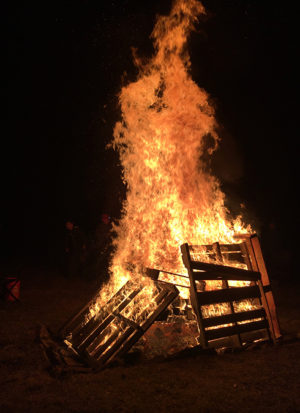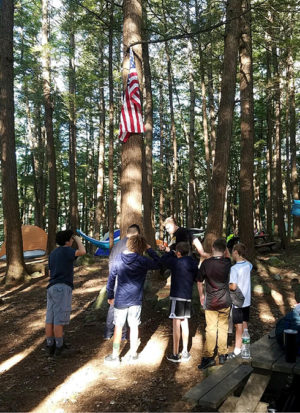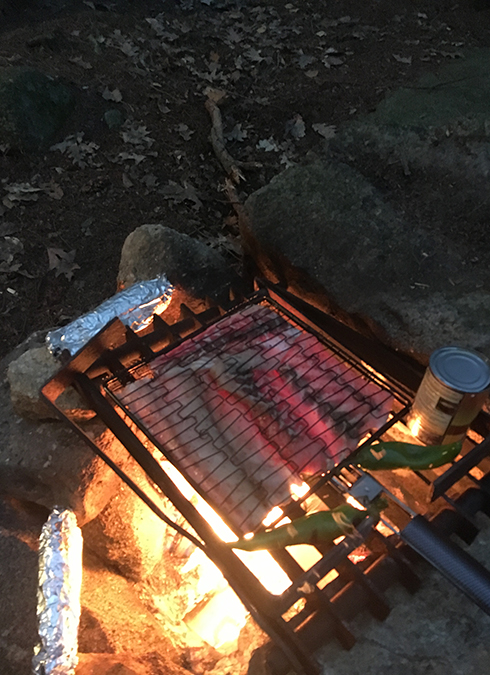



General Camping Advice
Sample packing list
Here is some general advice on what to pack for a typical Friday night – Sunday morning camping trip:
- Avoid cotton. You want “dry wicking” clothing of synthetic fiber like polyester, nylon, polypropylene and rayon. For example, the troop 41 class B red shirt. Cotton absorbs moisture and dries slowly; if you get wet/sweaty you get cold fast; avoid hypothermia, avoid cotton.
- For parents helping younger scouts pack, your scout should pack with you. Otherwise, the scout won’t be able to find any of their gear. If they pack it, they can find it.
- Your scout’s Boy Scout Handbook has a section on camping gear, with useful check-lists. See “camping gear, checklists” in the index.
- Finally, use stuff sacks or large (3 gallon) zip lock bags to keep things “organized” in the pack. Sleeping gear in one, cooking stuff in another, rain stuff in another, etc.
Backpack or Duffle Bag
Keep your stuff together, organized and ready to carry. Packing for a campout has been described as a bag full of bags. Rolling clothes, gathering sets with rubber bands, Zip-Loc bags or ditty bags allows the contents of a bag or backpack to stay organized and separates the clean dry clothes from the dirty and/or wet clothes. In the chaos of a scout’s tent or a winter cabin marking personal items can go a long way to bring a scout and his stuff together. It is very helpful to clearly mark the main bag in contrasting colors. For much of our camping the scout carries his stuff a short distance and a duffel bag will work fine. The troop also does some backpacking and a properly fitting backpack will be needed.
- One big duffle bag or backpack.
- One daypack to take on excursions (hikes, walks, etc.)
- Keep in mind it might be raining; if the bag isn’t waterproof putting everything inside a couple of trash bags inside your bag will keep clothing, sleeping bag dry. And if stuff is organized inside large zip lock bags, you have double protection.
Sleeping Bag and Pad
You need a comfortable place to sleep. The bed consists of a sleeping bag and a sleeping pad. Since this equipment is bought in adult sizes it makes sense to buy quality. For most camping a 20 degree bag works well, this is a personal choice and some have more than one bag depending on the temperature. If the scout is sensitive to the cold get a 0 degree bag. Dressing up with the proper clothes worn inside the bag can extend the bag for colder temperatures.
The sleeping pad or self-inflating air mattress is crucial to prevent loss of body heat to the ground. It also softens the ground a bit. During cold weather a warm hat is essential, as the head is a major source of heat loss. Change all clothes to make sure they are dry before going to bed – Avoid cotton.
During the heat of summer camp, a blanket and sheets is sometimes the best choice. For summer camp you will need a mosquito net with 4‘ dowels to hold it up.
- Sleeping bag – Temperature rating appropriate. Late-Fall/Winter trips require a zero degree or better bag.
- Sleeping pad
- OPTIONAL: camp pillow (or bring a pillowcase and stuff it with your “dry” clothes).
Outerwear
Be prepared for wet weather. A nylon-reinforced poncho is a good choice as it folds neatly and protects the head and upper body. A raincoat and pants does a better job but is not as easy to carry. A cheap plastic poncho can be carried in the daypack for emergencies because it folds so tightly but should not be a replacement for everyday use. Umbrellas are not used for a number of reasons.
Cold weather activities are a big part of scouting. Layering and the use of synthetic fibers allow the scout to be versatile while not carrying a ton of equipment. Also consider that scouts come home smelling like a campfire and these clothes need to be washed frequently. I find a fleece jacket and windbreaker covers a wide range of temperatures for the upper body. The fleece long johns with nylon pants will protect the lower body. Proper boots, socks, hats and gloves are essential as these are the parts of the body that gets cold first and are hardest to warm. Good hiking boots are used all year long. The main lesson is avoiding cotton.
- Rain Jacket and Rain Pants (Stay Dry!) Need these on every campout, always. Every time.
- Insulating Jacket Appropriate for the weather forecast. Keep in mind it will feel colder when you are outside for extended periods rather than if you are just out for an hour.
- Waterproof Footwear – hiking boots/shoes; above the ankle is better.
- Warm Hat – Useful for most trips; it doesn’t have to be that cold and windy before a hat makes one more comfortable.
- Warm Gloves (waterproof) – Useful for most trips.
Clothing
- Sleeping Outfit Always sleep in clean clothes. Option 1: some bring an outfit they only wear to sleep in Friday/Saturday night. Option 2: Others sleep in Saturday clothes on Friday night, and Sunday’s clothing on Saturday night.
- Clothes for to wear on Friday (travel day) – Assume these will be wet/muddy by bed time.
- Clothes for to wear on Saturday – Assume these will be wet/muddy by bed time.
- Clothes for Sunday (travel day)
- Extra socks, shirt, underwear.
Gear
Being environmentally conscious and thrifty means that everyone brings a mess kit. There are many choices and it can be as simple as a large bowl that can be used as a bowl or plate along with utensils and a hot liquid cup. The scout will also need some way to carry drinking water. Choices include a refillable water bottle or one of the backpack systems. Make sure that its top does not leak like some sports bottles do because it is often carried in a daypack with other item.
Everyone needs a light to find his way down the path in the dark and to sort things out in his tent. Headlamps that use LEDs are very effective. Flashlights also work and it often good to have a backup. Scouts should never use anything with a flame like a candle or lighter in his tent.
- Water Bottle One liter bottle minimum; better to have two.
- Mess Kit/Nesting Kit Boy scout mess kit, or a backpacking nesting kit (e.g GSI nesting kit)
- Utensils knife/fork/spoon
- Head Lamp or Flashlight (and extra batteries)
- Personal Hygiene Kit toothbrush/toothpaste, hand sanitizer/soap wash cloth and towel
- First-Aid Kit Walmart/Target has little kits that are cheap (or put together your own in a ziplock, see Scout Handbook). Yes, the Adults will have first aid kits, but we want our scouts to learn to be “self-sufficient” Later in life, a former boy scout will be the one that has the first aid kit when there is an accident.
Also Recommended for Most Trips:
- Sun Protection – Non-aerosol sunscreen is useful for most trips; now training your scout to use it….
- Bug Spray – Non-aerosol bug spray is a must have during spring/summer/fall camping trips.
- Brimmed Hat – Wide brimmed or even baseball hat is useful for most trips.
- Food – Scouts like having their own stash of snacks trail bars, trail mix. Try to pick healthy, but candy bars are admittedly popular.
- Compass – Useful for any trip involving hiking or orienteering.
- Whistle – Excellent safety device; sound travels farther and much less effort than shouting.
- Scout Handbook Pencil/Pen – Camping trips are the perfect time to get certain requirements done and signed off on.
- OPTIONAL – Cards, Games, Footballs, Frisbees, Fishing Gear
Where to Get Equipment?

Tent Care
As you know, the troop has tents for use, and we are working hard to prevent damage to the tents that we have seen in the past. After camping in a troop tent, your scout may be sent home with a tent to clean. Tents need to be cleaned and dried after camping. This is important to avoid mold forming on the tent fabric. We don’t want our scouts sleeping in foul, smelly, moldy tents. Mold is a safety issue because it can cause health problems. Cleaning and drying a tent after camping is an important responsibility so here are tips on how to do it.
How to Clean and Dry a Tent
- The tent needs to be cleaned and dried even if it did not rain. The tents can get quite wet from morning dew even if there was no rain or snow.
- Start cleaning the tent immediately after the campout. Do not leave the tent in the bag for more than 24 hours after camping.
- Clean out the interior of the tent. You can use a hand vacuum or broom. Wipe down dirty spots with a damp cloth. Tip: Set up the tent, unzip the door, then two people can lift the tent and shake debris right out the door!
- Clean the stakes with the hose or in a sink, and let dry. Shake out any dirt in the stake bag.
- Clean out the tent bag of debris. Let the tent bag, stake bag, and bag for the poles dry completely as well.
- Method One to Dry a Tent: Set up the tent completely, including the rain fly, and make sure it is well and truly DRY by leaving it up for a day or two. Tents can be set up inside in a DRY place, like a garage or basement. On a clear sunny day, a tent can be set up outside for at least 8 hours to DRY. DRY the tent completely to avoid mold.
- Method Two to Dry a Tent: Hang the tent body and the rain fly from a clothes line or on a deck so the air can circulate. Let the tent get well and truly DRY. If it rains, no worries, but leave it hang until a clear sunny day and the tent dries. The tent must dry completely to avoid mold.
- All the tent components and bags should be completely DRY before being repacked into the tent bag.
Helping your Scout
Cleaning and drying the tent is the scout’s responsibility, but he may need some help from his parents, especially younger scouts, to do it properly. The camping trips are fun, but we want our scouts to learn to take responsibility for preparing ahead of time, and for clean-up afterwards. Hopefully these instructions will help parents guide their scouts in proper tent care.
Exceptional Circumstances? Finally, if your physical circumstances (e.g. an apartment) present a challenge to drying a tent, please speak to our scoutmaster or assistant scout leader for for ideas on how to dry a tent in a small space.
